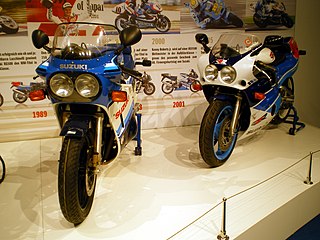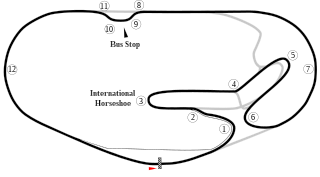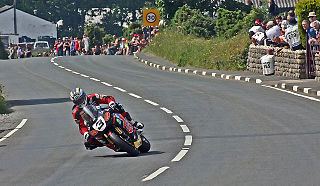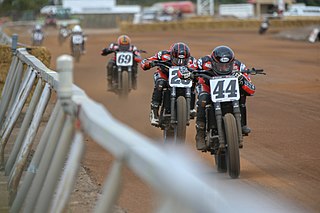
Grand Prix motorcycle racing is the highest class of motorcycle road racing events held on road circuits sanctioned by the Fédération Internationale de Motocyclisme (FIM). Independent motorcycle racing events have been held since the start of the twentieth century and large national events were often given the title Grand Prix. The foundation of the Fédération Internationale de Motocyclisme as the international governing body for motorcycle sport in 1949 provided the opportunity to coordinate rules and regulations in order that selected events could count towards official World Championships. It is the oldest established motorsport world championship.

Suzuki GSX-R is a series of sports motorcycles made by Japanese automotive manufacturer Suzuki since 1984.

A sports motorcycle, sports bike, or sport bike is a motorcycle designed and optimized for speed, acceleration, braking, and cornering on asphalt concrete race tracks and roads. They are mainly designed for performance at the expense of comfort, fuel economy, safety, noise reduction and storage in comparison with other motorcycles.

Neil Stuart Hodgson is a British former motorcycle racer, who won the 2000 British Superbike Championship, and the 2003 Superbike World Championship titles. He then went on to have a moderately successful four years in the American Superbike Championship, with a best 5th place championship finish.

Frederick Burdette Spencer, sometimes known by the nickname Fast Freddie, is an American former world champion motorcycle racer. Spencer is regarded as one of the greatest motorcycle racers of the early 1980s.

The Daytona 200 is an annual motorcycle road racing competition held in early spring at the Daytona International Speedway in Daytona Beach, Florida. The 200-mile (320 km) race was founded in 1937 when it was sanctioned by the American Motorcyclist Association (AMA). The original course used the beach itself before moving to a paved closed circuit in 1961. The Daytona 200 reached its zenith of worldwide popularity in the 1970s when the race attracted the largest crowds of any AMA race along with some of the top rated international motorcycle racers. The race is currently promoted by MotoAmerica and run in their middleweight Supersport Class. The race is typically held in early March.
Miguel Duhamel is a Canadian former professional motorcycle racer. He is the son of Canadian Motorsport Hall of Fame member Yvon Duhamel. He is tied with Toni Elias for the fourth-winningest rider in the AMA Superbike series with 32 wins. Duhamel was inducted into the AMA Motorcycle Hall of Fame in 2016.

The Senior Tourist Trophy is a motorcycle road race that takes place during the Isle of Man TT festival, an annual event traditionally held over the last week in May and the first week in June. The Senior TT is the blue ribbon event of the festival that takes place on the Saturday of race week, with "The Marquis de Mouzilly St. Mars trophy" awarded to the winner.

Doug Polen is an American former professional motorcycle road racer. Polen was a dominant national and world champion road racer in the late 1980s and early 1990s, culminating with his Superbike world championships in 1991 and 1992. He raced successfully in AMA Superbike, Japanese Superbike Championship, Superbike World Championship and endurance racing. Polen was inducted to the AMA Motorcycle Hall of Fame in 2011.
Eric Bostrom is an American professional motorcycle racer and brother of Ben Bostrom, who also races motorcycles professionally.
Superbike World Championship is a silhouette road racing series based on heavily modified production sports motorcycles.

The Supersport World Championship, abbreviated to WorldSSP, is a motorcycle racing competition on hard-surfaced circuits, based on mid-sized sports motorcycles. Competition machines were originally based on production-based motorcycles with 600 cc to 955 cc engines, depending on the number of cylinders. After trials in UK national series British Supersport, from 2022 the regulations have changed to allow eligibility of larger-displacement engines, to reflect the engine sizes being produced and encourage different manufacturers.

Superbike racing is a category of motorcycle racing that employs highly modified production motorcycles, as opposed to MotoGP in which purpose-built motorcycles are used. The Superbike World Championship is the official world championship series, though national Superbike championships are held in many countries, including the United Kingdom, the United States, Japan, Australia and Canada. Superbike racing is generally popular with manufacturers, since it helps promote and sell their product, as captured by the slogan "Win on Sunday; Sell on Monday".

American Flat Track is an American motorcycle racing series. The racing series, founded and sanctioned by the American Motorcyclist Association (AMA) in 1954, originally encompassed five distinct forms of competitions including mile dirt track races, half-mile, short-track, TT steeplechase and road races. The championship was the premier motorcycle racing series in the United States from the 1950s up until the late 1970s.

MotoAmerica is the organization that promotes the AMA Superbike Series since 2015. Sanctioned by the American Motorcyclist Association (AMA) and the Fédération Internationale de Motocyclisme (FIM), it features eight classes of road racing: Superbike, Stock 1000, Supersport, King of the Baggers, Super Hooligan National Championship, Twins Cup, Junior Cup, and Mini Cup.

Jason Pridmore is a retired American professional motorcycle racer who turned professional in 1990. He last raced professionally in the 2014 FIM World Endurance Championship on a BMW S1000RR for Team Penz 13. His professional career spanned 22 years, during which he won 21 American Motorcyclist Association (AMA) national races 17 of which are Superstock class wins which is second to Scott Russell. Pridmore was the AMA Formula Extreme Championship in 2002, the AMA 750 Supersport Championship in 1997 as well as the FIM Endurance World Championship title in 2003 & 2012 respectively. In addition to his professional racing career Pridmore instructs motorcyclists through his STAR Motorcycle school and JP43 Training programs. Pridmore also spends time as an expert analyst for Bein Sports coverage of the Moto America championships.
The 2020 MotoAmerica Championship was the 6th season of the MotoAmerica Championship.
The 2022 MotoAmerica Supersport Championship season was the 8th season of the MotoAmerica Supersport class. The defending class champion was Sean Dylan Kelly, who vacated his title during 2022 to race internationally in Moto2.













